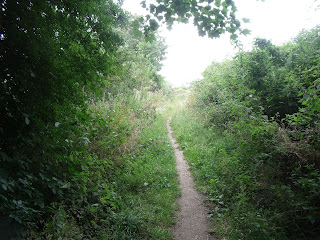Section 2
Abingdon to Oxford
 Leaving Abingdon I walked down the steps to the footpath with one last look at the bridge.
Leaving Abingdon I walked down the steps to the footpath with one last look at the bridge.I wonder if the flooding during the winter left this boat high and dry
 Up ahead is Abingdon lock and weir. Over the centuries the water channels carrying traffic have changed. The Swift Ditch which is now south of the main channel appears to have been the former course of the Thames but is now just a back water.
Up ahead is Abingdon lock and weir. Over the centuries the water channels carrying traffic have changed. The Swift Ditch which is now south of the main channel appears to have been the former course of the Thames but is now just a back water. Crossing over the Abbey stream the path now takes you through an attractive wooded area which is

full of wildlife. I could stay for hours watching the numerous butterflies and listening to the birdsong. But I estimate another 7 miles to go before I reach Oxford.
It is all part of Barton fields nature park. It is mainly volunteers who maintain our nature trails and areas, cutting back the unwanted weeds that try to take over the pathways. I would like to add how much my legs appreciated the lack of brambles and nettles growing across the path so thank you to volunteers everywhere.
 |
Nuneham railway bridge |

 Once past the bridge the Nuneham woods rise up on the opposite bank continuing for the next couple of miles.
Once past the bridge the Nuneham woods rise up on the opposite bank continuing for the next couple of miles.
It seems strange walking so close to someone's house. I find it impossible to walk on without being nosy and peering into their garden and home!
The houses on the opposite bank herald the approach of Sandford on Thames. Once home to a Victorian Mill this has now been replaced with housing.
Sandford Lock is the deepest lock on the non-tidal Thames with a drop of 2.68m. Built in 1630 it is one of the first 3 pound locks to be built. Pound locks are ones with gates at either end which allow the water to enter to raise the depth of the lock from the upstream to basically allow the boat to go uphill. The reverse happens when the boats are travelling downstream.
This is just part of the tremendous weir at Sandford. The weir pool known as the 'Lasher' has a very strong undercurrent. Although impressive it is also treacherous claiming the lives of several people.
This looks like a new hotel with a passengerboat moored outside which is possibly used as a floating restaurant.
First few drops of rain since I walked by Tower Bridge many, many miles away. It didn't last long and in fact it was much too warm to wear a rain jacket.
Running alongside the river is weir stream with the metal footbrige taking you across.
A welcome sign as I am more than ready for a sit down and rest. What I didn't realise at this point was that although Oxford was only 2 miles away, my hotel was a further 2 miles which was almost the straw that broke the camel's back making the day's mileage 16 instead of the 14 miles I had anticipated. I also had forgotten that my rucsac is much heavier than the usual day sac as I am carrying clothes etc for my 4 overnight stays.
The first wreckage I have seen on the river. Looking like the result of a fire, I am surprised it has not been removed as this is such a busy waterway.
Up ahead is the Kennington Railway bridge.
The river now runs under the Isis road bridge .
Iffley lock, the very first of the pound locks on the Thames built in the 1630s. Prior to pound locks, flash weirs were used. These weirs dammed the water to power the mills and provide navigation through shallow water. By removing a section of the weir the boats could 'flash' through with the current or be winched up against it.It was a dangerous
Leaving Iffley lock and weir this decorative bridge takes you back across to join the footpath again
Between Iffley lock and Oxford there are many college boathouses which store the racing rowing boats. It is along this stretch of the river that the rowing eight races take place in May.
Going under the Donnington Road bridge I am now on the approach to Oxford. The path is busy with cyclists and dog walkers. A sure sign I am near a town or in this case a city.
Just before Folly bridge is Salters Steamers, founded in 1858. Probably the most famous of the passenger boat companies that travel up and down the Thames. A welcome sight, telling me I have reached Oxford.
I left the river at Folly Bridge. This building is No 5 Folly Bridge. It is an interesting building with its iron balconies and niches filled with statues of the fallen women who supposedly worked here when it was a brothel.
This is Christ Church, founded in 1525 by Cardinal Wolsey, Henry VIII's Lord Chancellor. Almost 500 years later it is still here home to 550 undergraduate and postgraduate students studying a range of subjects.








































 St Michael and All Angels Church
St Michael and All Angels Church




















































